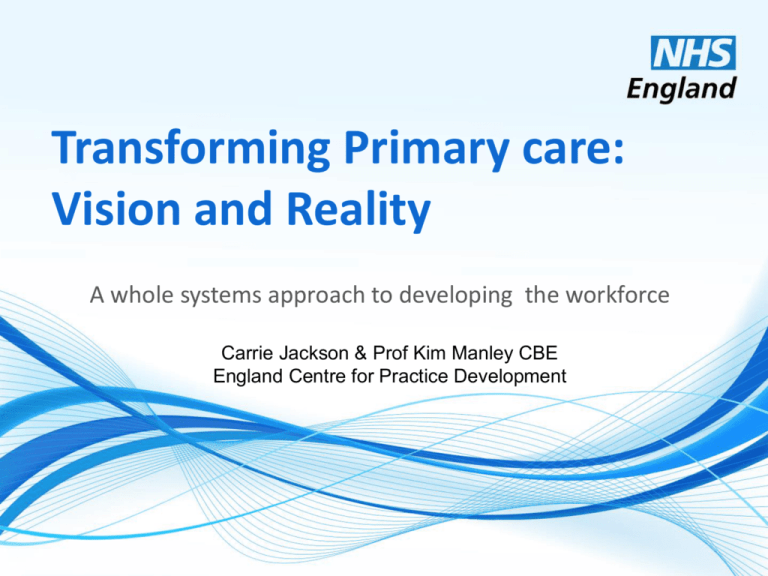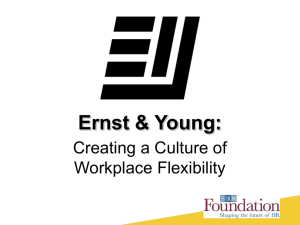Title of presentation
advertisement

Transforming Primary care: Vision and Reality A whole systems approach to developing the workforce Carrie Jackson & Prof Kim Manley CBE England Centre for Practice Development Overview • Assumptions underpinning presentation – whole systems approaches and the skills required for culture change • Developing a shared purpose for primary care. Drawing on: – Whole systems approach to urgent and emergency care – Implementing shared values – Developing shared purposes across organisations: EKHUFT/Community Trust/Mental Health Trust • Developing the skills sets to be leaders: • Aspiring Consultant Programme • CLP programmes across the multi-disciplinary team • Community of practice –Health Visiting • Capturing complex interventions to inform workforce development across community nursing roles • Integrating indicators of effective CPD into workforce development, learning & development activity Assumptions • Whole systems approach integrating the role of systems clinical leadership to make this happen • Links between whole systems clinical leadership and how culture change happens • Massive recruitment and retention agenda for all staff means that leadership needs to be exceptional Assumptions 1. Patients, service users and staff are at the top of the pyramid Patient/service users direct service providers Support services Board 2. Culture does not change through ‘training’, targets, compliance, directives or top down cascades Which Culture? • Organisational culture? • Workplace culture? • Team culture? • Practice culture? • Systems culture? • Corporate culture? ‘The most immediate culture experienced and/or perceived by staff, patients, users and other key stakeholders. This is the culture that impacts directly on the delivery of care.’ Manley, Sanders, Cardiff, Webster, 2012 Understanding the culture change journey (Manley 2014) Talking about purpose & values Relationships Agreeing shared values, purpose & ways of working together (values espoused) Challenging and supporting each other to LIVE the shared values & purpose (values lived) Embedding shared purpose & values in systems (‘Form follows function’) The core values underpinning effective workplace cultures Essential Attributes of Effective Workplace Culture (Manley et al 2011) Specific values promoted in the workplace, namely: •person-centredness •lifelong learning •support and challenge •leadership development •involvement and participation by stakeholders •evidence-use and development •positive attitude to change •open communication •teamwork •safety (holistic) Effective workplace culture Attributes 2-5: Embedding values & beliefs in practice 3. Adaptability, innovation & creativity maintain workplace effectiveness 5. Formal systems enable continuous evaluation of learning, evaluation of performance & shared governance 4. Appropriate change is driven by needs of patients/service users/communities 2. Shared vision, values direction realised in practice, with individual & collective responsibility Manley K; Sanders K; Cardiff S; Webster ) 2011 • Whole Systems Integrated Leadership • Workplace learning • Growing a critical community of people with skills to change the culture • Celebrate success and making improvements in real time • Working with live feedback • High challenge high support • R, D & I programme linked to shared purpose and key priorities Developing a Shared Purpose Framework Manley, O’Keefe , Jackson et al 2014 Project Partners: East Kent Hospitals University NHS Foundation Trust, SEACamb, NHS Ashford CCG, NHS Canterbury & Coastal CCG, NHS South Kent Coast CCG NHS Thanet CCG Kim Manley, Carrie Jackson, Ann Martin Juliet Apps, Ian Setchfield, Gemma Oliver Health Education Kent Surrey Sussex funded project INPUTS Enablers: •Commissioning •Leadership, expertise, ways of working •Staff recruitment, competence, role clarity, empowerment, support •Public information and understanding SYSTEMS LEADERSHIP More than a Case Manager/Co-ordinator! Culture Change expertise Joint Appointment Integrated Urgent & Emergency Care Whole System* (Any place, any context) SINGLE COMPETENCE FRAMEWORK: Interdependent Partners * Criteria identified •ASSESS •TREAT •SORT In any context INTEGRATED FLEXIBLE CAREER PATHWAY (NHS Career Framework) Work based facilitators of learning and development OUTCOMES •Timely care at time of crisis in the right place •Provision of urgent and high dependency care to prevent loss of life or ongoing illness •Consistent approach to care delivery across regional communities and population Curriculum Content •HEIs •FECs Workplace programme Accreditation •Promotion of positive workplace culture to enable person-centred care delivery •Improvements in mortality and other quality outcomes •Effective use of financial resources through reducing duplication of effort A whole systems approach to integrated urgent and emergency care COMMISSIONING • Whole pathway commissioningconjoined information, thinking & funding in the right place with shared risk-taking , Integrated electronic and information systems to enable data sharing, single patient record LEADERSHIP, EXPERTISE, WAYS OF WORKING: • Systems leadership that models and drives integration across boundaries, with expertise in culture change, effective teams and enabling • Access to clinical expertise across system and wherever it is needed & flexible referral system • Integrated collaborative interprofessional teamwork & partnership working (including first responders and service users) • Continuity of service and advice in different contexts STAFF RECRUITMENT, COMPETENCE, ROLE CLARITY, EMPOWERMENT, SUPPORT • Appropriate staff levels, role clarity, competence development and use, • Strategy to grow and retain staff for a stable workforce by: – Career progression framework – Learning & development incentives • Appropriate empowerment for effective decision making • Commitment to using the workplace as the main resource for learning, development, improvement and inquiry • Strong administrative expertise and support PUBLIC INFORMATION • Public education, and information to navigate the system • Clinical expertise, credibility for a specific client group (with case management) 50-60% of time in direct provision • Leadership to achieve culture change through working with shared purposes achieving integrated ways of working and effective teamwork across primary and secondary care and partner organisations • Creating a learning culture that uses the workplace as the main resource for learning, to maximise opportunities for learning and development, competence development and innovation • Enabling expertise to be accessed by as many people in the systems as possible through advanced consultancy approaches Making the complexity of community nursing visible The Cassandra Project Carrie Jackson, Prof Alison Leary, Tricia Leadbetter, Prof Kim Manley, Anne Martin, Dr Toni Wright False Assumptions about (Community) Nursing • We can rely on historical patterns to predict the future requirements • Nursing is linear • Nursing is a series of primarily physical tasks that occupy time- time and motion • Nursing is the application of a task based skillset with little decision making • Data collection mostly linear-measuring • Most current IT systems e.g. RIO, System One are diary based linear tools Worrying facts • Robust systematic workforce data is not available for planning for future needs • Workload calculations are based on time it takes to complete a task • Caseloads vary greatly in number and complexity • Variation of contact time from 15-20 minutes • Skill mix varies and current models will not sustain us going forwards • How can we really know the cost and impact of care left undone? Project Summary • 18 month research project (funded NHSE, HEKSS at regional level) • To find a workload activity tool that would enable us to understand the complex work of community nurses • To develop a method of capturing and analysing these data • To test a model (Cassandra) previously developed for the specialist nurse/case managing community Activity of specialist advanced practice nurses Things that specialists do Outcomes Emotional effort Physical Psychological Intervention Social Things that Cassandra records time context Admin Care management numbers date form What does the Cassandra Tool do? • Minimum 70-100 hours activity per practitioner • Intervention, context, time, people, care left undone/activity left undone • Instant report generation at 70 hours • Organisational report providing detailed analysis of workload activity across bands Findings so far from pilot • Approx. 11,000 points of data • 7,629 interventions collected in 58 regularly used categories • Issues with collection (not enough for a “big data” study) but shows complexity of care. • 112 examples of care left undone Spread across the intervention spectrum (2x context) Modelling is about building a representative “whole system” rather than trying to measure bits Our model gives good insight Garbage data Great model Garbage results Poor decisions Great data Garbage model Garbage results Poor decisions Great data Great model Great results INSIGHT! Next Steps in Cassandra • Develop data ontology for community nursing • Data collection allowing for pattern recognition through NIHR bid • Optimum caseload calculations using stochastic methods • Detailed analysis of workforce resourcing patterns and gap analysis • Economic impact assessment through Burdett Trust programme at RCN Transcending organisational & workplace cultures in mental health- the Sophia Project • 12 months developing a mental health workload activity tool for community MH teams • Working with front line staff to develop from scratch • Using principles underpinning Cassandra Project • Conceptual model built, Sophia (Goddess of Wisdom) chosen by staff in open competition • Ready to test May • If you are interested in being a pilot site contact us! Developing skills in culture change • In house programmes – to develop a critical community – – – – e. Aspiring Consultant programme Inter-disciplinary clinical leadership programmes Facilitating individual effectiveness programmes Medical Clinical leadership programmes • Communities of practice to develop leadership and also empowered professionals who can implement what is required in an integrated way e.g., Health Visiting Community of Practice Health Visiting Research Themes BEGINNING END Getting to know group and networking Working as a group towards collaborative action What is a cop? Developing HV practice as a CoP collectively Learning about self Becoming more confident Clarifying and valuing role Confidence and clarity with role and contributing to future health care – more political Learning about tools to use in practice with teams Beginning to use tools with others Developing reflection and enabling skills to reflect on practice Becoming reflective and enabling others to reflect, challenge and support recognising the importance of feedback Developing theoretical insights to practice Theorizing from their own practice Health Visiting Community of Practice Kent & Medway Action Research Study 2015 England Centre for Practice Development @CoPKandM Developing a culture of effectiveness in Health Visiting placements Unreceptive/ underdeveloped Culture Triggers • • • • • • • No shared vision about Student HV or Newly qualified HV Poor retention of newly qualified staff Service needs vs. students needs Different opinions on supporting students in consolidated practice placement No team meetings Staff are not retained Staff leaving to undertake specialist roles START Source of evidence PRACTICAL STRATEGIES Set up team meetings Clarify with Team Leader the guidance on students in Consolidated Practice Talking to students about how they are feeling Best evidence about supporting students is implemented Reconnect with values of the service user contract between 10-16 weeks Developing a learning culture Asking students for feedback on challenge and support AN EFFECTIVE WORKPLACE CULTURE • Retain newly qualified HV on qualification • Students and staff perceive that the culture is positive • Shared vision held and implemented about supporting HV placements and practice learning • Team working • Team strategy for retaining students and staff END Source of evidence CPD Impact Tool for quality care: context, mechanisms, outcome and impact • • • • HEE Education Outcomes Framework Realist synthesis and evaluation over 12 months 2 phases of development Result an impact tool to measure impact of CPD learning on patient experience outcomes in the workplace • Indicators of effectiveness for individuals, teams, service and organisations • IMMINENT RELEASE! Take home messages • Future workforce planning and development requires a whole systems approach • Focus on development of leadership capacity across the whole system • Workforce development requires robust modelling that takes time • Innovation should be based on best evidence rather than fad and fashion for sustainability • Growing a critical mass of culture change agents at the front line really matters Thank you from the England Centre for Practice Development @ECPDCarolyn, @KimManley8 @ECPD3 # WePracticeDevelopers www.canterbury.ac.uk/englandcentreforp racticedevelopment www.facebook.com/groups/ecpd1 • IPDJ free online access journal at www.fons.org







